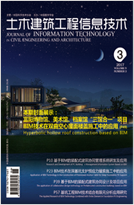2023, 15(4): 64-72. doi: 10.16670/j.cnki.cn11-5823/tu.2023.04.11
基于数字孪生的电力小型基建智慧建造关键因素研究
| 1. | 国网天津市电力公司后勤工作部,天津 300384 |
| 2. | 国网天津电力公司电力科学研究院,天津 300384 |
| 3. | 福建亿力电力科技有限责任公司,福州 350000 |
| 4. | 天津大学,天津 300072 |
A Study on the Key Factors of Digital-Twin-based Smart Construction in Small-Scale Power Infrastructures
| 1. | Logistics Department of State Grid Tianjin Electric Power Company, Tianjin 300384, China |
| 2. | State Grid Tianjin Electric Power Company Electric Power Research Institute, Tianjin 300384, China |
| 3. | Fujian Great Power Science and Technology Co., Ltd., Fuzhou 350000, China |
| 4. | Tianjin University, Tianjin 300072, China |
引用本文:
姜又滔, 郭博文, 张迅达, 田宏心, 王悦, 程明, 崔兵, 任可. 基于数字孪生的电力小型基建智慧建造关键因素研究[J]. 土木建筑工程信息技术,
2023, 15(4): 64-72.
doi: 10.16670/j.cnki.cn11-5823/tu.2023.04.11

Citation:
Youtao Jiang, Bowen Guo, Xunda Zhang, Hongxin Tian, Yue Wang, Ming Cheng, Bing Cui, Ke Ren. A Study on the Key Factors of Digital-Twin-based Smart Construction in Small-Scale Power Infrastructures[J]. Journal of Information Technologyin Civil Engineering and Architecture,
2023, 15(4): 64-72.
doi: 10.16670/j.cnki.cn11-5823/tu.2023.04.11

摘要:针对电力行业的小型基建项目,本研究结合DEMATEL和ISM方法,探究影响成功实施智慧建造的相关因素,分析获得关键因素以及因素间的影响路径。使用MICMAC方法进行因素归类,分析系统中各因素之间影响与依附关系。最后,针对模型分析的结果对如何在电力行业小型基建项目中成功落地智慧建造理念提出相应对策。
Abstract: Taking small-scale infrastructure projects in the power industry as the research object, this paper combines the DEMATEL and ISM methods to explore the relevant factors that influence the implementation of digital-twin-based smart construction and obtains the key factors and influencing path among factors under analysis. In this paper, the MICMAC method is used to categorize the factors and analyze the influence and dependency relationships among the factors in the system. On the basis of research results under integrated model analysis, the paper provides suggestions on how to successfully implement smart construction in small-scale infrastructure projects in the power industry.
| [1] |
QIN X, SHI Y, LYU K, et al. USING A TAM-TOE MODEL TO EXPLORE FACTORS OF BUILDING INFORMATION MODELLING (BIM) ADOPTION IN THE CONSTRUCTION INDUSTRY[J]. JOURNAL OF CIVIL ENGINEERING AND MANAGEMENT, 2020, 26(3): 259-277.doi: 10.3846/jcem.2020.12176 |
| [2] |
王树平, 刘宗宝, 郝庆斌, 等. 全国数字化审图、政府购买服务人工智能(AI)审图情况的调研报告[J]. 中国勘察设计, 2021(02): 68-79. |
| [3] |
刘倩. 基于模糊层次分析法的电网小型基建风险管理的应用研究[D]. 天津大学, 2018. |
| [4] |
PHANG T C H, CHEN C, TIONG R L K. New Model for Identifying Critical Success Factors Influencing BIM Adoption from Precast Concrete Manufacturers' View[J]. Journal of Construction Engineering and Management, 2020, 146(4): 4020014.doi: 10.1061/(ASCE)CO.1943-7862.0001773 |
| [5] |
GONG P, ZENG N, YE K, et al. An Empirical Study on the Acceptance of 4D BIM in EPC Projects in China[J]. Sustainability, 2019, 11(5): 1316.doi: 10.3390/su11051316 |
| [6] |
吕坤灿. 基于TAM-TOE模型的BIM技术采纳与应用策略研究[D]. 华侨大学, 2017. |
| [7] |
HAN K I, KIM Y, CHOI J. Development of IFC Property Extension Structure for Automated Building Code Checking in the Architectural Design Phase[J]. 2018, 23(3): 233-244. |
| [8] |
胡海涛, 潘存瑞, 张雷, 等. 新基建对智慧工地建设的影响分析[J]. 中国建材科技, 2020, 29(05): 28-97. |
| [9] |
赵智勇, 杨德胜. 基于泛在电力物联网的后勤智慧房产平台研究[J]. 微型电脑应用, 2021, 37(12): 125-129. |
| [10] |
李承明. BIM技术支持下的混凝土框架结构施工图智能化审图方法[J]. 智能建筑与智慧城市, 2021(12): 93-94. |
| [11] |
贺浩, 于刘王, 盛利杰. 建筑设计院BIM正向设计推行难点及对策[J]. 中华建设, 2020(09): 102-103. |
| [12] |
QIN J, XI Y, PEDRYCZ W. Failure mode and effects analysis (FMEA) for risk assessment based on interval type-2 fuzzy evidential reasoning method[J]. Applied Soft Computing, 2020, 89: 106134.doi: 10.1016/j.asoc.2020.106134 |
| [13] | |
| [14] |
WU J, ZHANG J. Model Validation Using Invariant Signatures and Logic-Based Inference for Automated Building Code Compliance Checking[J]. Journal of Computing in Civil Engineering, 2022, 36(3). |
| [15] |
AJZEN I, FISHBEIN M. Understanding Attitudes and Predicting Social Behavior[J]. Journal of Experimental Social Psychology, 1980, 278. |
| [16] |
徐欣, 王伟. 推进基于BIM技术的正向设计的难点分析[J]. 建筑设计管理, 2019, 36(11): 64-67. |
| [17] | |
| [18] | |
| [19] |
ELSHAFEY A, SAAR C C, AMINUDIN E B, et al. Technology acceptance model for Augmented Reality and Building Information Modeling integration in the construction industry[J]. Journal of Information Technology in Construction, 2020, 25: 161-172. |
| [20] | |
| [21] |
WU J, AKANBI T, ZHANG J. Constructing Invariant Signatures for AEC Objects to Support BIM-Based Analysis Automation through Object Classification[J]. JOURNAL OF COMPUTING IN CIVIL ENGINEERING, 2022, 36(4). |
| [22] |
DAVIS F D. Perceived Usefulness, PerceivedEase of Use, and User Acceptance of InformationTechnology[J]. MIS Quarterly, 1989, 13(3): 319. |
| [23] |
VENKATESH V, MORRIS M G, DAVIS G B, et al. User Acceptance of Information Technology: Toward a Unified View[J]. MIS Quarterly, 2003, 3(27): 425-478. |
| [24] |
DAVIS V F D. A Theoretical Extension of the Technology Acceptance Model: Four Longitudinal Field Studies[J]. Management Science, 2000, 46(2): 186-204. |
| [25] |
DAVIS F D, VENKATESH V. A critical assessment of potential measurement biases in the technology acceptance model: three experiments[J]. International Journal of Human-Computer Studies, 1996, 45(1): 19-45. |
| [26] |
MA P, ZHANG S, HUA Y, et al. BehavioralPerspective on BIM Postadoption in Construction Organizations[J]. Journal of Management in Engineering, 2020, 36(1): 4019036. |
| [27] |
蒋鹏. M公司大羊供电所项目全过程管理研究与应用[D]. 山东科技大学, 2019. |
| [28] |
秦娜, 王建波, 张娜, 等. 基于DEMATEL-TOPSIS的城市轨道交通PPP项目融资风险动态评价[J]. 青岛理工大学学报, 2021, 42(06): 21-28. |
| [29] | |
| [30] |
LIANG Y, WANG H, ZHAO X. Analysis offactors affecting economic operation of electric vehicle charging station based on DEMATEL-ISM[J]. Computers & Industrial Engineering, 2022, 163. |
| [31] |
GONG C, XU H, XIONG F, et al. Factors impacting BIM application in prefabricated buildings in China with DEMATEL-ISM[J]. Construction Innovation-England, 2021. |
计量
- PDF下载量(31)
- 文章访问量(2108)
- HTML全文浏览量(1309)















